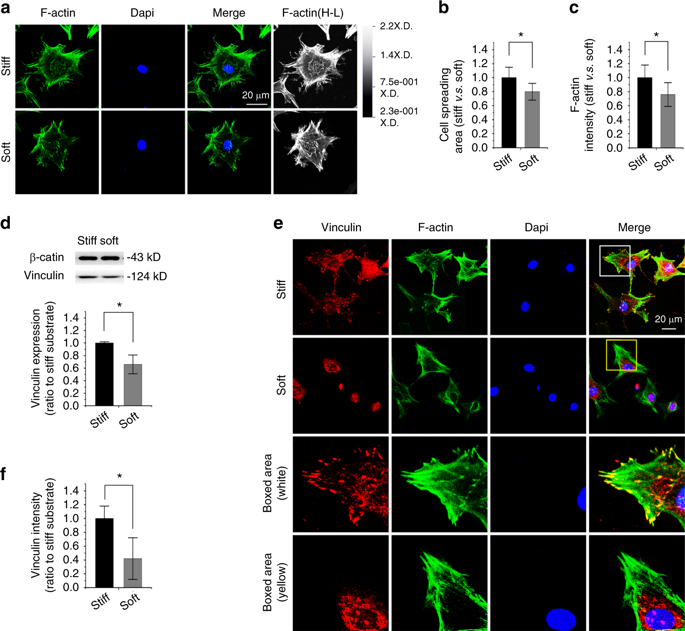International Journal of Oral Science ( IF 10.8 ) Pub Date : 2019-06-01 , DOI: 10.1038/s41368-019-0052-3 Chenchen Zhou 1 , Qingxuan Wang 1 , Demao Zhang 1 , Linyi Cai 1 , Wei Du 1 , Jing Xie 1

|
The biophysical properties of the extracellular matrix (ECM) dictate tissue-specific cell behaviour. In the skeleton system, bone shows the potential to adapt its architecture and contexture to environmental rigidity via the bone remodelling process, which involves chondrocytes, osteoblasts, osteoclasts, osteocytes and even peripheral bone marrow-derived stem/stromal cells (BMSCs). In the current study, we generated stiff (~1 014 ± 56) kPa, Young’s modulus) and soft (~46 ± 11) kPa silicon-based elastomer polydimethylsiloxane (PDMS) substrates by mixing curing agent into oligomeric base at 1:5 and 1:45 ratios, respectively, and investigated the influence of substrate stiffness on the cell behaviours by characterizing cell spreading area, cell cytoskeleton and cell adhesion capacity. The results showed that the cell spreading areas of chondrocytes, osteoblasts, osteoclasts, osteocytes and BMSCs were all reduced in the soft substrate relative to those in the stiff substrate. F-actin staining confirmed that the cytoskeleton was also changed in the soft group compared to that in the stiff group. Vinculin in focal adhesion plaques was significantly decreased in response to soft substrate compared to stiff substrate. This study establishes the potential correlation between microenvironmental mechanics and the skeletal system, and the results regarding changes in cell spreading area, cytoskeleton and cell adhesion further indicate the important role of biomechanics in the cell-matrix interaction.
中文翻译:

顺应性基质调节骨骼细胞粘着斑块中新蛋白的表达。
细胞外基质(ECM)的生物物理特性决定了组织特异性的细胞行为。在骨骼系统中,骨骼显示出通过骨骼重塑过程使骨骼的结构和环境适应环境刚性的潜力,该过程涉及软骨细胞,成骨细胞,破骨细胞,骨细胞,甚至外周骨髓衍生的干细胞/基质细胞(BMSC)。在当前的研究中,通过将固化剂按1:5的比例混合到低聚碱中,我们产生了刚性(〜1,014±56)kPa,杨氏模量)和软(〜46±11)kPa硅基弹性体聚二甲基硅氧烷(PDMS)基材分别以1:45的比率进行,并通过表征细胞扩散面积,细胞骨架和细胞粘附能力来研究底物刚度对细胞行为的影响。结果表明,软骨细胞的细胞扩散区域,相对于硬质基质,成骨细胞,破骨细胞,骨细胞和骨髓间充质干细胞在软质基质中均减少。F-肌动蛋白染色证实,与僵硬组相比,软组的细胞骨架也发生了变化。与硬质基质相比,粘膜斑块中的长春花碱显着降低了对软质基质的响应。这项研究建立了微环境力学与骨骼系统之间的潜在相关性,有关细胞扩散面积,细胞骨架和细胞粘附性变化的结果进一步表明了生物力学在细胞-基质相互作用中的重要作用。F-肌动蛋白染色证实,与僵硬组相比,软组的细胞骨架也发生了变化。与硬质基质相比,粘膜斑块中的长春花碱显着降低了对软质基质的响应。这项研究建立了微环境力学与骨骼系统之间的潜在相关性,有关细胞扩散面积,细胞骨架和细胞粘附性变化的结果进一步表明了生物力学在细胞-基质相互作用中的重要作用。F-肌动蛋白染色证实,与僵硬组相比,软组的细胞骨架也发生了变化。与硬质基质相比,粘膜斑块中的长春花碱显着降低了对软质基质的响应。这项研究建立了微环境力学与骨骼系统之间的潜在相关性,有关细胞扩散面积,细胞骨架和细胞粘附性变化的结果进一步表明了生物力学在细胞-基质相互作用中的重要作用。











































 京公网安备 11010802027423号
京公网安备 11010802027423号